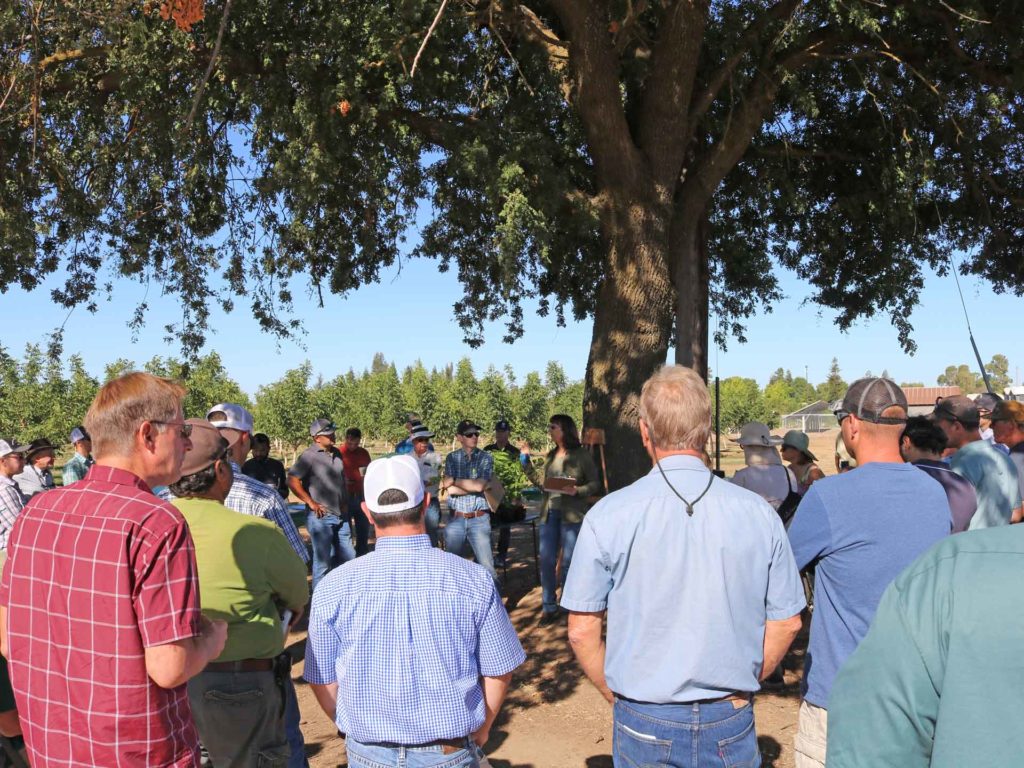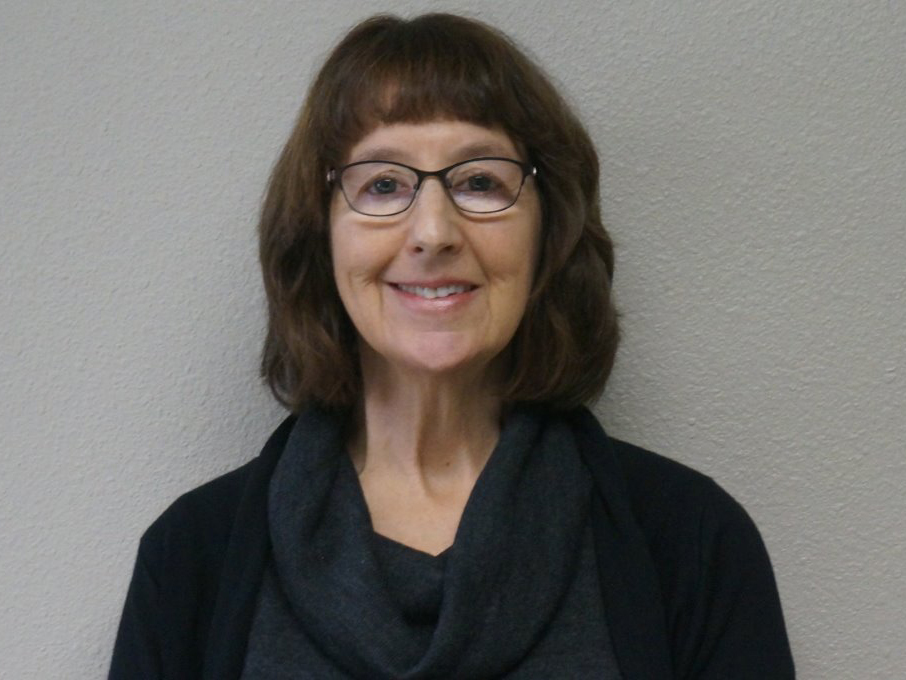One of Janine Hasey’s first duties as a University of California Cooperative Extension (UCCE) intern was to lead a meeting for walnut growers and explain what was causing blackline disease in their orchards.
“There was a great turnout of about 100 people,” Hasey recalled. “My mentor and great pomologist, Dave Chaney, let me run the meeting. This was going to be the first local meeting on what caused the disease.”
Blackline disease, she told growers at the meeting, is caused by cherry leafroll virus and spread from tree to tree with infected pollen. That meeting not only launched a 38-year career as a UCCE advisor in Sutter and Yuba counties for Hasey, but also sparked a long-time commitment to help walnut growers become more productive and profitable.
Dedication
Growers, fellow farm advisors and researchers have agreed that Hasey’s dedication to finding solutions for production problems led to numerous improvements in walnut rootstock development, disease control, pest control, irrigation management, pruning and numerous other production practices.
Collaborative Research
Through collaborative research, Hasey said, she sought to deliver reliable information to growers that would help them make planting and management decisions. She emphasized that throughout her career, the research was almost always a true collaborative effort with fellow UCCE, University of California (UC), and United States Department of Agriculture (USDA) colleagues, growers, and nurseries.
Hasey said the seriousness of blackline disease in walnuts at that time pushed efforts to find new rootstocks that were tolerant to the disease and would allow orchards to be planted where blackline was a production challenge. She did field testing with walnut breeding pioneers including Gale McGranahan on rootstocks as well as on new varieties. Clonal propagation of English walnut and walnut rootstocks using tissue culture was just beginning back in the 1980’s. Walnut is difficult to clonally propagate, she said, but McGranahan believed that using this method to develop own-rooted English trees could help growers overcome problems with blackline. They also experimented with cloning rootstocks setting the stage for elite clonal testing in the early 2000’s for rootstock tolerance or resistance to nematodes, Phytophthora, and crown gall. By 1987, Hasey had a rootstock trial in Rio Oso that included several black walnut species and one of the first with clonal Paradox. Even back then she observed less crown gall on the clonal Paradox compared to the seedling Paradox rootstock, a trend we see today with our clonal rootstocks.
Own-rooted English Walnut Trees
“After the cause of blackline was determined by Dr. John Mircetich, we really weren’t sure how fast the disease would continue to spread in the early 1980’s. That’s how I got interested in own-rooted English walnut trees”, Hasey said. Being all English with no rootstock, these clonal trees don’t die from blackline disease like when English are grown on black or Paradox rootstock. By 1991, Hasey planted the first own-rooted Chandler trial at the Whitney Warren Ranch in Rio Oso with trees provided by researcher John Driver who propagated them from cultures of English walnut from the McGranahan lab. In this replicated trial they were able to compare these with seedling Paradox rootstock over an 11-year period.
Hasey subsequently led additional replicated trials, surveys and screening studies that allowed her and fellow researchers to determine own-rooted English walnut susceptibility to nematodes, disease, and environmental factors. This allowed them to help growers determine if these trees are suitable to their sites in areas where blackline is prevalent. One survey looked at every own-rooted English walnut tree in the field for crown gall incidence which they found to be very low.
Walnut grower Brent Barton of San Joaquin County is one of the many growers who have benefitted from Hasey’s and her colleagues’ research. Based on their field trials, Barton and others were able to make planting decisions to overcome challenges for their growing areas. Due to the blackline issue in that area, using own-rooted English trees in good soils proved to be the best choice.
Hasey noted that the concern back in the early 80’s that blackline would become a significant problem in all walnut growing counties fortunately has not been the case. The same area in her counties where blackline was most prevalent back then still is and it has remained at about the same low levels in most walnut growing counties outside the major impacted Delta and coastal regions over her career.
Emerging Trends in Cropping Patterns
Hasey’s work also pointed out an emerging trend in cropping patterns to help the industry plan for long term increases in production. During a sabbatical leave in the early 1990s, she published, “Maintaining the Competitive Edge in California’s Walnut Industry” a long-term strategic plan for land use and production in walnut through the UC Davis Ag Issues Center. This publication grew from interviews with every walnut advisor in the state and county agricultural commissioners in counties where walnuts were grown. It evaluated land use and cropping patterns and projected that there would be a conversion to tree crops including walnuts in many areas where field crops were grown in several counties. By the early 2000s and continuing, the predictions were proven true.
New Challenges
New challenges to walnut production over the years that Hasey became involved in included pistillate flower abscission, higher incidence of crown gall, the spread of Botryosphaeria in walnuts, flood and drought effects on production, frost damage, thousand cankers disease, and walnut replant disease.

David Ramos, UC Davis walnut specialist emeritus, said Hasey was one of the key extension advisors involved in not only rootstock development, but in training and pruning walnuts.
“She was a valuable link in bringing walnut grower needs to the attention of UC researchers and played a lead role in field trials for rootstocks. We could not have done that without her,” Ramos said.
Rootstock Research
Hasey has been the lead advisor on clonal Paradox rootstock research trials throughout the state that are testing new disease resistant genotypes bred by USDA, UC, and UCCE researchers with funding through the Federal Specialty Crop Research Initiative (SCRI) grant and the California Walnut Board. The new genotypes are being compared to our standard clonal Paradox RX1, VX211, and Vlach that were cloned and screened in the early 2000’s and have been adopted by many growers to deal with site specific problems. As a farm advisor emeritus, Hasey plans to continue to oversee these rootstock plots and work with the newer walnut advisors.
The next generation of UCCE advisors is now poised to continue rootstock research to help growers’ specific needs in the field.
One of those UCCE advisors is Luke Milliron, an orchard systems advisor in Butte County who counts Hasey his mentor.
Hasey’s Impact on Walnut Production
Her impacts on local walnut production have been tremendous, Milliron said, noting her leadership following the 2017 flooding that left many acres of walnuts standing in water for months. Hasey’s work in training young walnut trees and pruning has also contributed to the industry.
“She brought a wealth of skills and an immense repository of knowledge to farm visits and field diagnosis. Hasey’s example of cutting through to address the most critical needs faced by her growers has been the greatest mentoring of all. I am incredibly thankful not only to have her as my mentor, but to have her on speed dial for my next tough field diagnosis.”
Ramos also noted that Hasey entered her career with UCCE at a time when there were very few women farm advisors.
“As one of the first woman farm advisors in California, there was concern that the growers might not accept her, but she became one of the top advisors in the state. She is a remarkable role model for women who want to become farm advisors.”
Hasey noted the many changes in the walnut industry including Chandler now being well over half the statewide production from just a few orchards at the beginning of her career, along with clonal rootstock development and the several nursery products now available to growers. Perhaps the biggest change in walnut culture she has witnessed though was discovering through our UCCE research, that we don’t have to prune using heading cuts on lateral bearing walnut scaffolds to keep them growing during the training stage. This was a major paradigm shift in walnut production that can save growers costs on labor and brush removal and often results in increased early production.

Cecilia Parsons
Cecilia Parsons has lived in the Central Valley community of Ducor since 1976, covering agriculture for numerous agricultural publications over the years. She has found and nurtured many wonderful and helpful contacts in the ag community, including the UCCE advisors, allowing for news coverage that focuses on the basics of food production.
She is always on the search for new ag topics that can help growers and processors in the San Joaquin Valley improve their bottom line.
In her free time, Cecilia rides her horse, Holly in ranch versatility shows and raises registered Shetland sheep which she exhibits at county and state fairs during the summer.
















